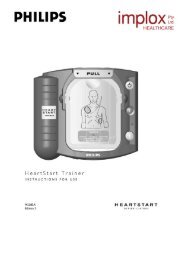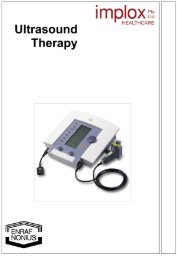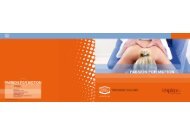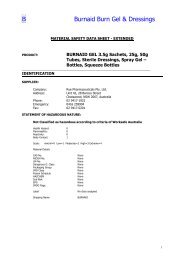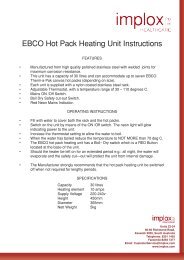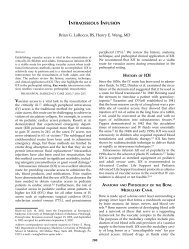CASMED 740 Vital Signs Monitor - Implox
CASMED 740 Vital Signs Monitor - Implox
CASMED 740 Vital Signs Monitor - Implox
You also want an ePaper? Increase the reach of your titles
YUMPU automatically turns print PDFs into web optimized ePapers that Google loves.
<strong>CASMED</strong> <strong>740</strong> <strong>Monitor</strong>s<br />
FRONT PANEL INTENSITY CONTROL<br />
The <strong>CASMED</strong> <strong>740</strong> <strong>Monitor</strong> utilizes Super Bright LED displays in its front panel for better viewing<br />
in a variety of environments. If the displays are too bright or should the need come to operate<br />
the monitor in a dimly lit environment, the monitor incorporates a user selectable Intensity<br />
Control.<br />
Press and hold the front panel VOLUME pushbutton for two (2) seconds. The monitor’s front<br />
panel LED displays will toggle from their bright to their dim intensity level.<br />
Continue to press the VOLUME pushbutton and every two (2) seconds the monitor’s front panel<br />
LED displays will toggle; dim to bright, bright to dim etc. Release the VOLUME pushbutton and<br />
select the intensity level required. The <strong>CASMED</strong> <strong>740</strong> <strong>Monitor</strong> remembers this setting and will<br />
power-up the next time to the intensity level selected.<br />
DISPLAYING THE TIME<br />
The <strong>CASMED</strong> <strong>740</strong> <strong>Monitor</strong> can be used to display the current Time of day (as set by the user) at<br />
any time. Press and hold the CYCLE TIME pushbutton for two (2) seconds.<br />
The monitor displays the Time, in 24 Hr. format in the Message Window for as long as the<br />
pushbutton is pressed.<br />
MANUAL MODE FOR BLOOD PRESSURE DETERMINATION<br />
Select and apply the appropriate sized cuff for the patient being monitored to the extremity.<br />
Refer to Section 5, BLOOD PRESSURE MONITORING for more information.<br />
Connect the cuff to the end of the monitor tubing. Connect the monitor tubing to the NIBP<br />
connector, located on the left side of the monitor.<br />
To select one of the Initial Inflation Pressures shown in TABLE 4, press either the ARROW UP<br />
or the ARROW DOWN pushbutton or accept the default Initial Inflation Pressure of 150 mmHg<br />
(Adult) or 85 mmHg (Neonate).<br />
CAUTION:<br />
When measuring blood pressure on a Pediatric patient, using the ADULT mode, it is<br />
recommended that the Initial Inflation Pressure be set to a lower value of 120 mmHg.<br />
ADULT MODE NEONATE MODE<br />
200 mmHg 120 mmHg<br />
180 mmHg 100 mmHg<br />
160 mmHg 85 mmHg<br />
150 mmHg 80 mmHg<br />
140 mmHg 60 mmHg<br />
120 mmHg<br />
100 mmHg<br />
80 mmHg<br />
Table 2: Selectable Initial Inflation Pressures<br />
21-02-0298 REV. 00 12/06<br />
85





